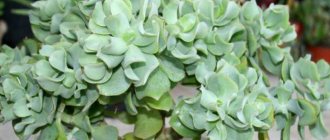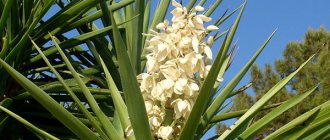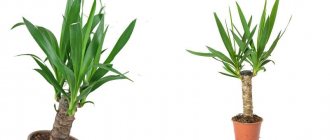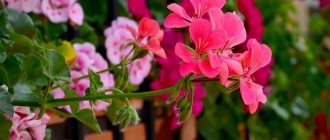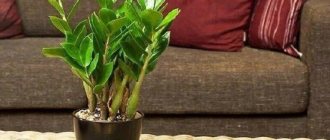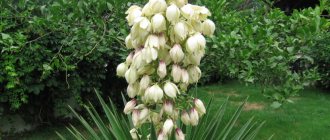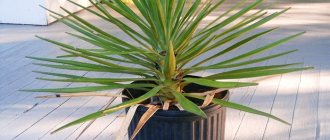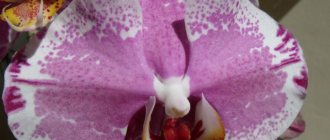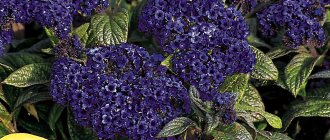Indoor yucca - description
Surprisingly, this beautiful, bright green creature, which lifts your spirits just by looking at it, belongs to the aspargus family. That is, in simple words, asparagus. Unexpected, right?
This is an evergreen plant that can look different (depending on the variety), but always has a trunk and elongated, pointed leaves that grow to form a dense rosette. It grows slowly, but it can easily tolerate dry air, and this is a very valuable quality for an indoor flower, considering that the air in Russian apartments is dried by heating devices most of the year.
The length of the leaves and the height of the false palm itself varies from variety to variety, but on average it grows about a meter in height, and the leaves can reach half a meter in length. Interestingly, they taper towards the end: at the base they usually reach fifteen centimeters, and in the middle they narrow to three to five. The color of the leaves varies from variety to variety, but as a rule they are shades of green interspersed with other colors.
Is Yucca a palm tree or not?
No, not even close, although it is sometimes called an indoor palm or palmita. Indoor yucca just looks vaguely like a palm tree. And so - nothing in common, only a visual similarity, and even that is dubious.
Where does yucca grow - the plant’s homeland
America as a continent. Yucca (not indoor, but wild) is distributed throughout all parts of the continent: in the countries of North, South, and Central America, as well as on the Caribbean islands.
Does indoor yucca bloom at home and how?
Yes, it blooms, and very beautifully: at the bottom of the indoor yucca there is a basket of long horizontally arranged leaves, and the trunk is literally studded with large (up to seven centimeters) white and pink bells.
However, it is very difficult to achieve indoor yucca flowering at home; careful care is required. The main obstacle that prevents indoor yucca from blooming is the lack of light.
How fast it grows
Yucca indoors is a slow-growing creature. For example, if you grow it from a seed or cutting, then only after three years a young but already mature flower will form.
Plant height
Depends on the variety, usually ranges from 50 to 100 centimeters, but there are varieties reaching four meters.
Is Yucca poisonous or not?
No, it is not poisonous, although, of course, you should not eat it for breakfast. Yucca is even used to make medicines.
Types of Yucca
There are about 30 varieties of yucca, but not all of them can be grown in the middle zone. Let's look at some of the most interesting species!
Berry yucca
Its fruits are edible and resemble sweet potatoes in taste and look like bananas. This yucca has a very rough and short trunk, bluish leaves, and it grows up to 1.5 m.
Photo: happyho.ru
Pale Yucca
Its leaves really appear faded and bluish. The height of the rosette under favorable conditions reaches 2 m. It blooms in mid-summer with white flowers.
Photo: dekorsad56.ru
Yucca Carnerosana
The tall Mexican species grows up to 3.5 and in the spring blooms with white buds that gradually turn pink. This yucca thrives in full sun and partial shade.
Photo: etsy.com
Aloe leaf yucca
It got its name for its resemblance to the hard, sharp and rough leaves of aloe. Gradually, the old leaf plates darken, droop and surround the trunk with a kind of skirt.
Photo: zolininkas.lt
Yucca Schidigera
It was nicknamed the Spanish dagger for its dangerously sharp leaves. In nature, it grows up to 2 m and blooms with spectacular buds with a purple tint.
Photo: commons.wikimedia.org
Beaked Yucca
It is also called blue because of the gray-blue tint of the leaves. Against this background, pale cream-colored flowers collected in large inflorescences look even more tender.
Photo: dizainexpert.ru
Blue yucca
Leaves 60 cm long grow in the form of a basal rosette and have a bluish tint. On sandy soil, the plant produces a powerful, tall peduncle of up to 15 buds, and after flowering the rosette dies.
Photo: deserthorizonnursery.com
Giant Yucca
It is also an elephant tree, and in nature it grows up to a fantastic 9 m. It is a drought-resistant species. And, oddly enough, this is exactly the kind of yucca that can be grown perfectly in the house.
Photo: moiugodya.ru
Tall Yucca
The decorative look is especially loved by landscape designers. It is relatively low, with beautiful pale leaves, and is also very frost-resistant and can withstand up to -23 degrees.
Photo: coposic.ru
Brugmansia (50 photos): types, cultivation and care in open ground
How to care for Yucca at home
Here you will learn how to provide yucca with conditions under which it will feel good and delight you with a healthy appearance. Any disease is easier to prevent than to cure, so it is important to initially create comfortable conditions for indoor yucca, since diseases often develop due to care errors: for example, excessive humidity.
What to do after purchase
After purchasing, you must firstly transplant the green pet into a new pot. This is done because the transport soil does not have the proper amount of nutrients. How the transplant is carried out - read in the corresponding section.
Secondly, you need to quarantine your new green pet, that is, place it separately from the flowers you already have for a week. This is done in order to observe the new pet: whether he brought any infection from the store that could infect the flowers you already have.
Thirdly, you need to choose a place where the indoor yucca will stand and move it there after quarantine. It is advisable to pre-clean this place and wipe off the dust so as not to infect the new tenant through dirt.
Lighting
This is the main difficulty in caring for this unpretentious flower: it needs a lot of light, so choose an eastern or southern room, and in summer you can even put it on a balcony or open ground. In winter, it is appropriate to place yucca under ultraviolet lamps.
Content temperature
Indoor yucca comes from the tropics, so it loves warmth. In summer, the preferred temperature is 25-30 degrees, and in winter it should not fall below +11⁰С.
It is important to avoid drafts, so do not place indoor yucca under an air conditioner or fan, and do not open the windows next to it when it is cold.
Humidity
The flower does not like humidity and often suffers from its excess with fungal diseases. Therefore, it does not need to be sprayed and it is even permissible to place it next to the heating device.
How to water yucca
If the plant is young, then you need to water it every day, but little by little, just to slightly moisten the soil. If the plant is mature, then water it abundantly, but rarely - once every two weeks. In summer – once a week, because it’s hot.
Watering rules:
- Water only when the top layer of soil is dry;
- The water from the pan must be drained after watering, otherwise the roots will rot;
- Make sure that the soil absorbs water and does not remain only on the top layer. If the top layer is wet for several days in a row, loosen the soil so that the water passes down.
In summer
Once a week because it's hot. If the summer is cool and rainy - once every two weeks.
in winter
When cold weather sets in and the temperature does not rise above 18 degrees, watering is reduced to once a month.
Fertilizer and feeding
Required only in summer to support the abundantly growing organism. In summer, nitrogen fertilizing is introduced. There is no need to fertilize in winter, spring, or fall.
Types and varieties of garden yucca
Garden yucca is the most common plant in cultivation. It forms leaf rosettes, consisting of leaf plates pointed at the top, characterized by high density.
The genus Yucca unites many species, with the most widespread species in cultivation being: Filamontesa, or filamentous (Yucca filamentosa); pendulous (Yucca flaccida); gray (Yucca glauca Nutt.).
Yucca filamentosa
Yucca flaccida
Yucca glauca Nutt
In the rather harsh climate of mid-latitudes, the most commonly grown plant is Yucca filamentosa, which is native to the southeastern part of North America, characterized by a warm and dry climate. This spectacular plant is found naturally in the Atlantic coastal belt (Florida to Maryland).
Yucca filamentosa is part of the Agave family. This perennial plant forms a spectacular bush, the woody and short stems of which are partially buried in the soil. Highly decorative panicle-shaped inflorescences consist of hanging bells of a bluish or creamy white hue. As a rule, flowering of such a plant is observed from July to August.
Large and tall panicle-shaped inflorescences can break due to strong winds. In this regard, it is necessary to install a suitable support for the plant. Its inflorescences are very tall - up to 200 cm. The flowering bush produces a large amount of sweet nectar, which attracts bees and butterflies.
Did you know that! Yucca flowers are used as food in Mexico. They are baked in batter or added raw to salad. They contain large amounts of vitamin C.
This evergreen perennial plant stands out for its unusual leaf rosette. It consists of many narrow, ribbon-shaped leaf plates that are similar in appearance to the tail of a swallow. The edges of the plates are curled, and they are painted in a dull greenish-blue hue. These unusual and spectacular leaf rosettes reach a height of about 0.7 m.
Different varieties of yucca may have external differences. In the summer, Yucca pendula develops widely branched stems. The length of the flowers of the Juka flaccida ivory variety is about 60 mm. It was obtained by English breeders in the last century. This variety is very resistant to frost (down to minus 21 degrees).
There are types and varieties of yucca, the foliage of which is multi-colored. For example, varieties of yucca filamentous:
Bright edge Color guard
Ivory Towers Golden Sword
Variegata
- Bright edge . The height of the bush is only about half a meter. There is a white border along the edge of the leaf plates.
- Color guard . The bush consists of sword-shaped leaf plates with a green edge. Inflorescences of cream flowers form on stems about 200 cm high. The plant blooms in June.
- Ivory Towers . The foliage has a white edge.
- Golden Sword . The height of such a perennial plant together with stems can reach up to 250 cm.
- Variegata . This garden variety has a white edge on the foliage.
Trimming and shaping
This process is carried out annually. The optimal time is the beginning of spring, when indoor yucca is full of strength and can calmly heal the cuts after the procedure. Autumn-winter is a bad time for pruning, because then the plant’s body is weakened and it may not have enough strength to heal the cuts.
Pruning is carried out for the purpose of aesthetically shaping the plant, to stimulate its growth, and also to obtain shoots for reproduction.
Step-by-step instruction:
- Two days before pruning, water your indoor yucca thoroughly and do not water again until pruning.
- Prepare sharp garden shears or pruning shears, sharpen them properly, and treat them with alcohol. Prepare crushed activated carbon - you will need it to disinfect the cut areas.
- Inspect the flower and cut off excess shoots, holding them by the leaves. The cut is carried out in one motion, the first time, immediately after it is processed with ground coal.
- The main rule: do not allow the stem to break off and always leave at least half a meter, otherwise you will harm the plant, it may even die.
- After pruning, leave the plant in a sunny, warm room, but away from direct sunlight. Watering is reduced to once a month. Fertilizers are introduced (also monthly) to help indoor yucca produce new shoots.
- If you have an indoor yucca with several trunks, then each year you need to prune only one shoot, otherwise the plant will not be able to recover after the procedure.
Main types
As was said, yucca flowers are represented in nature by several dozen species; below are the most common of them, which people use for decorative purposes:
- Yucca aloefolia. This plant is most often grown among the yucca genus by amateur gardeners. When mature, it reaches a height of 1.5 meters, the pointed leaves have a rich green color and are collected in bunches at the top of the trunk. The plant is characterized by magnificent yellow-white inflorescences that appear in the summer. Among the varieties of Yucca aloelia, Yucca "variegata" should be distinguished, which is characterized by light green leaves with cream-colored edges. Aloe yucca is called the “Spanish bayonet” in many South American countries.
- Yucca elephantis, or elephant yucca. It originates from Mexico and Guatemala. This type of plant is called elephant because its trunk expands towards the base and becomes like an elephant’s leg. In the wild, elephant yucca grows up to 15 meters, but in houses its height does not exceed 2 meters. Like Yucca aloe, the leaves grow from the tops of branches or the trunk. The leaves are light green in color and curl as they age. Elephant yucca flowers are white in color.
- Yucca shortifolia. This is a typical desert flower that grows in the wild in the Mojave Desert in the USA (California, Arizona, Utah). The plant has short leaves, which, when collected in bunches, provide an ideal nesting site for some bird species. The peculiarity of this type of yucca is that it can grow for 500 years.
- Yucca "rostrata". This species is native to the desert areas of Mexico and Texas, in particular the Chihuahuan Desert, where "rostrata" can be seen growing in rocky terrain. Of all the types of yucca, it is the “rostrata” that most closely resembles a palm tree due to its characteristic crown and thick trunk. A photo of the Yucca "rostrata" flower is shown below.
Yucca Reproduction
In this section you will learn how to plant indoor yucca and get a new, young plant in various ways: from seeds, from cuttings, from lateral shoots or by dividing the bush. Regardless of the method you choose, remember that all operations are carried out exclusively slowly, carefully, carefully, so as not to harm the flower.
If the transplant method you choose uses a knife or scissors, they must be sharp, and before doing anything with them, be sure to wipe the blades with alcohol. This is done in order to cause minimal harm to the plant and not introduce any infection (bacteria may appear on an instrument that has not been disinfected).
All cuts must be made at an angle of forty-five degrees. This is done so that if you take something away from an indoor yucca, it will be easier for it to grow new shoots (leaves, branches) in that place.
Also, regardless of the method, you will need a container where you will transplant the future young flower, and soil.
The soil will need to be loose (to provide oxygen to the root system) and nutritious, since a young growing organism will need more nutrients than an already mature plant. It is recommended to mix the soil from sand, turf, peat and black soil (in equal proportions).
The material of the container does not matter, but it must be equipped with holes to prevent stagnation of water in the ground. The size is still small, since the root system of the plant is still tiny. A large capacity will lead to “fatification,” that is, to the development of the root part instead of the ground part.
Cuttings
Propagation by cuttings is of two types: apical cuttings and stem cuttings. By apical cuttings is the simplest method, suitable for non-professionals, but propagation by stem cuttings is a more complex method.
The ideal time for propagation by cuttings is early spring, when indoor yucca has just woken up and begun to grow.
How to propagate from apical cuttings
How to propagate by tips:
- Cut a rosette of several leaves from the top of the mother plant. It is desirable that there be at least a couple of leaves, or better yet two or three, and that they are healthy, green, and elastic. It is also permissible to take a cutting with a branch, but it should not be too long, just a small piece.
- Leave the cutting to dry for two to three hours, then you need to remove the lower leaves.
- After this, plant it in the ground and cover it with glass or polyethylene. Moderate watering is necessary: so that the soil is always only slightly moist, not allowed to dry out, but nothing more, because excessive watering plus greenhouse conditions create conditions for sprouts to rot.
- The greenhouse is ventilated once a day for ten minutes and condensation is removed from the inside. This is necessary to prevent the cuttings from rotting.
The roots will appear in a month and a half, then you can transplant the cutting into a larger pot, remove the greenhouse and care for it like an adult plant.
You can also carry out cuttings in water. Then you need to immerse the cutting in water in which three or four tablets of activated carbon are dissolved (for disinfection), but otherwise the sequence of actions is the same.
How to propagate from stem cuttings
After trimming the tops, you will be left with a trunk. If it has grown more than twenty-five centimeters, then it can be treated with ground crushed coal and any root growth stimulator, and then cut and planted in nutritious soil.
An important point: you need to plant it the way the trunk grew before, that is, first mark the end of the trunk that was sticking up, otherwise your flower will grow down into the ground and die.
Soon two or three buds will appear. To make them appear faster, you can use a growth stimulator.
After the buds appear, fertilizing is introduced. Fertilizer needs nitrogen, it gives the plant strength to grow.
The future indoor yucca must be placed in a bright place, but not exposed to direct sunlight.
Dividing the bush
Reproduction by dividing a bush is not much different from propagation by cuttings. The only difference: cuttings, as a rule, do not have a root, but when dividing a bush, you can take a shoot so that all parts of the future plant are there: roots, stems, leaves. Such a shoot needs to be transplanted into regular soil for indoor yucca, but with the addition of humus, it will give the young plant more nutrients. Further rules of care are the same as for cuttings.
If you couldn’t separate the bush with its roots, it’s okay: you first need to plant it in coarse sand under a greenhouse so that it takes root. True, this is a slow process: the roots will appear only after a month and a half. After this, the bush is planted in a separate pot and cared for like an adult plant.
It is optimal to divide the bush in August. The mother plant must be large and overgrown so that it does not suffer from the fact that part of the sprouts will be taken from it, but on the contrary, it feels better and is rejuvenated.
Seeds
- Damage the seed coat. Yes, you heard right, it needs to be slightly cut. This is called stratification and helps speed up the growth of the future green pet.
- Place them (don't dig them deep, just lay them) on loose, nutritious soil and cover with polyethylene or glass.
- Provide a suitable temperature (at least 25 degrees).
- Don’t forget to ventilate and wipe away condensation from the greenhouse.
- When the seedling has the first pair of its own leaves, it can be transplanted into a separate pot.
Lateral processes
- Make a cut forty centimeters below the lowest leaves and remove a “belt” of bark from the trunk one and a half centimeters wide at this point. Place a layer of damp moss on the exposed area and cover the top with plastic so that the moss always remains moist.
- After a while, roots form in the moss, and then a lateral shoot. Wait until the roots have grown enough and then cut off the shoot with a sharp tool.
- Do not forget to treat the cut with ground activated carbon in order to immediately kill any possible infection that could remain there after an insufficiently clean instrument, and plant the shoot in the soil for an adult yucca.
Transfer
Yucca is replanted immediately after purchase, and then every 2-4 years, in the spring, when the pot becomes small for the plant. An extraordinary transplant is required in case of rotting of the root system.
The soil for the plant must have neutral or medium acidity (pH 5.5-7.5). You can use a ready-made substrate for palm trees and dracaenas, or prepare a soil mixture yourself, mixing humus, compost, turf soil and coarse sand in equal proportions.
Transplant process:
- At the bottom of the flowerpot, place a layer of drainage at least 5 cm thick, made of pebbles, expanded clay or broken brick.
- Sprinkle some of the prepared soil mixture on top.
- Take the Yucca out of the old pot along with the earthen lump and place it in the center of the new pot.
- Cover the plant with substrate so that the stem is buried a maximum of 3 cm.
Reference. The plant is suitable for growing hydroponically.
Transplanting Yucca domestica
How to transplant yucca at home, step-by-step instructions:
- Wash the pot you will be planting in thoroughly with hot water and soap.
- Place two to three centimeters of expanded clay on the bottom and partially fill it with soil mixture (approximately to the middle of the pot).
- Treat the soil mixture with a fungicide, as indoor yucca suffers from soil-borne fungal diseases.
- Carefully remove the yucca from the previous pot. Taking this opportunity, be sure to inspect the roots: have they begun to rot? If this is the case, then cut off the rotten parts with sharp scissors and sprinkle the sections with ground activated carbon.
- Place the plant in a new pot and fill in the remaining soil so that there are no air spaces. Lightly tamp down near the trunk.
- Water the plant generously (if there was no root rot, if there was, then watering is not recommended for the next two to three days).
When can you replant?
Transplantation is carried out either in emergency cases (for example, if the plant is infected with pests or fungi), or it is a planned transplant due to the growth of indoor yucca. Such a transplant is carried out every two to three years if the plant is mature (over five years old) or annually if the plant is young and developing quickly. With each transplant, the pot grows a little.
The optimal time of year for transplantation is early spring.
Priming
The composition of the soil includes peat, turf and coarse sand in a one to one ratio. If the plant is young, then it would be appropriate to add humus. Also don’t forget a two to three centimeter layer of expanded clay (can be made from crushed brick). If you decide to buy ready-made soil for indoor yucca, then peaty, neutral acidity will do.
What kind of pot is needed for yucca
When replanting, a pot for yucca is of great importance. Its size is calculated as follows: proceed from the idea that the pot should be three to four larger in scope than the root ball of the plant. And its height should be two to two and a half times greater than the diameter.
That is, conditionally: if the diameter of the yucca root ball is fifteen centimeters, then the diameter of the pot is nineteen, and the height or depth is thirty centimeters (all numbers are taken conditionally to demonstrate the principle).
The material of the pot is not so important, but it must be resistant to damage and heavy enough so that the tall, branched, tree-like yucca does not accidentally outweigh it.
Planting and caring for yucca
- Flowering: decorative deciduous plant, does not bloom at home.
- Lighting: bright sunlight (near the south window). There should be at least 16 hours of daylight, so in winter you will need additional artificial lighting.
- Temperature: in summer – normal for residential premises, in winter – not lower than 10 ˚C.
- Watering: abundant, after the soil has dried to a depth of 5-7 cm.
- Air humidity: any, but dry air is easier to tolerate.
- Top dressing: from April to August, once every 2-3 weeks, yucca leaves are sprayed from the underside with a very weak (twice weaker than the manufacturers recommend) solution of complex mineral fertilizer.
- Dormant period: from October to February.
- Transplantation: in spring, once every 2-4 years.
- Reproduction: seeds, apical cuttings, parts of the trunk.
- Pests: scale insects, spider mites, aphids, thrips.
- Diseases: stem and root rot, bacteriosis, gray and brown spots, bacterial burn.
Read more about growing yucca below.
flower (lat. Yucca) belongs to the genus of evergreen tree-like plants of the Agave family, although not so long ago it was included in the Liliaceae subfamily. Sometimes the plant is called "yucca palm", although it has nothing to do with palm trees. In floriculture, trees such as yucca and dracaena are called false palms. Yucca is native to the arid regions of Mexico and Central America. All 30 plant species are divided into two groups: stemless and tree-like. In nature, the tree-like yucca plant can grow up to 12 meters in height, while domestic yucca grows no higher than 2 m.
- Reproduction of Dieffenbachia: digging in the apical shoot
This is a beautiful, low-maintenance tree that can serve as a worthy decoration for a large room or office. Yucca flowers are sometimes called the “denim tree” because the first denim fabric was made from their fibers.
Diseases and pests of Yucca and their treatment
In this section we will talk about the most common problems associated with diseases and pests of indoor yucca.
Diseases
- Cercospora blight.
Symptoms: light brown spots with a dark outline on the leaves. The spots gradually increase in size and then merge together.
Why did this happen: as a rule, this disease is caused by waterlogging of indoor yucca: excessive watering, spraying.
What to do: cut off damaged shoots, treat the cuts with a solution of potassium permanganate, and then treat the entire plant with a fungicide two to three times at intervals of ten days.
- Brown spotting.
Symptoms: at the initial stages of the development of the disease, light spots appear on the lower leaves of indoor yucca. The light spot turns yellow, and then the leaf dries out and turns brown. Small dark growths are noticeable on the spots - this is the fungus that brought the brown spot with it and is spreading further.
Why this happened: waterlogging of the soil.
What to do: remove damaged shoots as soon as possible and treat with potent fungicides.
- Fusarium rot.
Symptoms: the danger of this disease is due to the fact that it is invisible in the early stages. Visually it becomes noticeable when it has already developed strongly: you will see the bases of the leaves rotting.
Reason: like any rot, fusarium rot appears due to waterlogging of the plant.
What to do: treat with fungicides several times at intervals of ten days; if that doesn’t help, destroy the plant. In this case, the soil for indoor yucca and the pot are also destroyed, since from there the fungus that carries the disease can spread to other plants.
- Leaf necrosis.
Symptoms: gray spots on the edges of leaves, sometimes wet.
What to do: remove the damaged shoots entirely or at least their damaged parts, sprinkle the sections with ground activated carbon (for disinfection, so that no other infection penetrates into the plant through the damaged, tender place), then treat with a fungicide.
- Stem rot.
Symptoms: darkening of the trunk, then a soft trunk of the yucca, ulcers oozing something liquid appear on it. One of the most dangerous diseases for indoor yucca often leads to the death of the plant.
What to do: carefully cut off the damaged part of the trunk. The cut is made with a sharp, disinfected instrument two to three centimeters above the damaged part. The cut part is destroyed (for example, burned). The cut is treated with a fungicide and then sprinkled with ground activated carbon. In this case, the soil for indoor yucca also needs to be treated with a fungicide.
- Root rot.
Symptoms: the complexity of this indoor yucca disease is that it is difficult to notice from the outside, since it affects the roots; often owners notice root rot only when replanting the plant, when they notice that the roots have darkened and become soft. From the outside, root rot is manifested by slow growth, yellowing and wilting of leaves.
What to do: if the lesion has not yet managed to capture most of the root system, it is necessary to cut off the diseased roots and sprinkle the sections with ground activated carbon. Then you need to transplant the indoor yucca into a pot where the soil has been treated with a fungicide, and do not water it for some time after transplantation until it takes root. If the root rot has spread greatly, the plant will have to be destroyed.
Pests
- Shield.
Symptoms: Hard, raised, clearly visible growths on the leaves, followed by sticky droplets. If nothing is done about this, then, firstly, indoor yucca will not receive enough nutrients, since some of its juices are drunk by the scale insect, and secondly, in the sticky and moist environment created by its waste products, fungus easily develops.
What to do: treat the plant with a soft cloth or cotton wool soaked in a soap or alcohol solution, treat the soil with an insecticide (three times with an interval of ten days).
- Spider mite.
Symptoms: the leaves first lighten, then a white coating and a thin cobweb appear on them.
What to do: treat with an insecticide and then spray with a soap solution or garlic decoction.
- Mealybug.
Symptoms: clumpy, cotton-like patches, general limp, yellowed appearance of the plant.
What to do: wash with soapy water to wash away all existing parasites, then treat the plant with an insecticide four times at weekly intervals.
- Aphid.
Symptoms: You will notice the insects themselves (tiny bugs: green, clear or brown) at the bases of the leaves. Aphids drink the juices of the plant and secrete a sticky substance in which the fungus readily develops.
What to do: spray with soapy water and then treat with insecticides. Treatment must be started immediately: aphids are very voracious.
Introduction
From the flowers that are cut from the plant, you can extract juice, which contains a very large amount of sugar. Yucca filamentous is a source of durable fiber, which is excellent for making clothing and denim, and then yucca fibers began to be gradually replaced by cotton, although yucca is still very popular in this area. And today in America, yucca fibers are added to fabrics, since it makes the fabric dense and wear-resistant, and this is a huge plus. In addition to the fact that the fiber is used to make clothing, it is also widely used to make rope and paper. The plant also has some healing properties that should also be taken into account. In this article we will talk in more detail about this plant, describe its most striking properties and characteristics. We will also tell you how to grow yucca and care for it at home, what species are common in culture today, what properties and characteristics these same species have, and why they are so famous and loved by flower growers themselves.
Popular varieties of indoor Yucca with photo and name
It would seem that yucca is a plant that does not imply diversity of species. But still it exists, albeit not very numerous.
Elephant (Elephantis, Elephantipes)
One of the largest varieties, can reach several meters in height. Multi-stemmed variety, the trunk is thick and tree-like. Very reminiscent of a palm tree.
Gray
It blooms more readily than others even at home, as well as by the shape of the bush (perfectly round, made of thin, militantly protruding shoots) and cold dark green color.
Glorious
Very similar to the previous one, but the leaves are slightly wider and also decorated with a thin light border along the contour. The color is very beautiful, similar to the color of spruce needles.
Aloifolia
The name matches the content: thanks to the bright green, rich color and shape of the bush, this variety really resembles aloe.
Variegated
Quite wide leaves taper towards the end, the bush is round, low, rather tends to grow horizontally. Leaves with a light underside and edge.
Rostrata
An interesting variety that you don’t immediately recognize as a yucca: single-stemmed, with a thick, long trunk and a semicircular cap of thin blue-green shoots.
Coracoid
The variety is very similar to the previous one, but much smaller and lower, but the bush, on the contrary, is more luxuriant, and the blue tint of the foliage is more pronounced.
Copstack
A modest variety that is well suited for decorating offices: not too tall (70 cm), with a small number of slightly rounded leaves growing in a rosette.
filamentous
One of the most common varieties. It blooms more readily than others, blooms magnificently and beautifully. If it does not bloom, it pleases with the rich blue-green hue of the leaves.
Yucca - description of the plant
Yucca culture comes from the American continents. It has spread over a wide area, including Mexico, Central and South America. In natural conditions, it can most often be found in dry areas.
But thanks to its decorative qualities, yucca has already conquered the whole world. In many southern European cities you can find large tree-like and shrub-like specimens. In the photo - yucca, popular on the Spanish coast:
Despite the visual similarity, yucca is not a palm tree. These plants belong to different families. Although in everyday life you can often hear this home flower called the yucca palm.
Yucca is an evergreen plant that forms large rosettes of sword-shaped (hard, narrow and long) leaves. These rosettes are planted on a low trunk, which does not branch at all, or only slightly.
In some varieties of the crop, it is impossible to see the trunk, since the foliage hangs too much around it. Looking at indoor species, you will notice that the yucca stem is covered with a waxy, dense bark. This property prevents moisture loss and increases the survival of the tree in hot conditions.
In its natural environment, yucca can appear as a tree, reaching a height of eight meters, or as a lush bush. Indoor options extend up to two meters.
What the Yucca palm tree brings to the house: signs and superstitions
How is indoor yucca useful from the point of view of physiology and strict evidence-based science? Indoor yucca is, first of all, an excellent oxygen generator.
Large plant with large green leaves. It grows, goes about its legitimate business - photosynthesis - during which it absorbs carbon dioxide and produces oxygen instead. Thanks to this, the air in the room is purified, it becomes easier to breathe, and accordingly, the inhabitants of this room think better, sleep more peacefully, and their overall well-being and mood improve, because the level and quality of oxygen in the blood affects the condition of the entire body.
And from the point of view of bioenergy, signs, and various philosophies, the following interesting facts are associated with yucca:
- It is believed that indoor yucca has a positive effect on the energy in the house. It prevents conflicts between family members, helps to make informed decisions, and feel calmer and more confident. From a scientific point of view, this effect can actually be achieved by improving the quality of oxygen in the house, and consequently, mental abilities.
- It is also believed that indoor yucca attracts good luck, positive energy, and material well-being.
- A beautiful and sad legend is associated with indoor yucca: supposedly the first yucca in the world appeared because it was abundantly watered with tears by a passionately in love young man who could not be with his beloved. Therefore, it is believed that indoor yucca strengthens marriage and prevents adultery.
- According to the philosophy of Feng Shui, plants such as indoor yucca are best placed in offices, rooms where people work, negotiate, and engage in creative work, since indoor yucca clarifies thoughts, calms, helps to concentrate, and reason about difficult situations sensibly and balancedly .
- They say that if you bury a few coins in a pot of indoor yucca, this will attract material wealth to your home.
- But there are also negative superstitions: for example, it is believed that you should not refuse someone who asks you for a branch of indoor yucca to grow his own yucca. This plant does not like greedy people; it generously gives away its energy to everyone around it and will attract failure to the owner who interferes with it. It is also believed that an unmarried person should not grow indoor yucca: the energy of the plant scares off potential spouses.
- According to Feng Shui, before choosing a plant, you need to look at its leaves. If they have a pointed shape, it means that this plant carries with it Yang energy, it will motivate achievements, stimulate action. If the leaves are round, then this is a plant with Yin energy - it will calm, pacify, promote the thought process, and immersion in oneself.
General characteristics of the plant
The yucca flower (photo above) originates from the regions of Central, South and North America. It is characterized by a thick brown trunk and long, sharp green leaves that are collected in rosettes. Yucca flowers are white in color and emerge from the central part of the plant on a long, thin stem. Currently, several dozen different species are classified as members of the Yucca genus. In the wild, the flower can grow up to 15 meters in height, but at home their height does not exceed 2 meters. It is interesting to note that although yucca fruits are edible, they are not used on a large scale in gastronomy.
Photos in the interior
Features of growing yucca
Since the yucca flower grows in tropical and subtropical zones of the planet, sunlight for it is the main factor for healthy growth, since it not only provides the necessary process of photosynthesis, but also promotes flowering of the plant. There should be a lot of sunlight for yucca, because it is one of the few flowers that needs exposure to direct sunlight. In this regard, it is recommended to place a flower pot in a sunny place in the summer.
Yucca is a relatively unpretentious plant in terms of air temperatures. So, in the summer, 25 °C is the normal temperature for its growth and development. In winter, it is desirable that the air temperature does not fall below 10 °C, so it is better to keep the flower indoors in a well-lit place during the cold period.
Yucca is also unpretentious to cool air currents, which are common if the plant is located outside.
Every gardener who grows a yucca flower should know that in the morning, when the sun is not yet active, it is recommended to spray the leaves of the plant with water from a spray bottle. Such actions are designed to increase humidity near the crown of the plant, simulating the natural conditions of its residence in a tropical climate.
Common diseases of yucca
- Cercospora - brown spots on the leaves gradually increase - excess moisture. Stop watering and slightly reduce the humidity in the room, stop spraying, remove damaged leaves. If the damage is too severe, replant in a dry substrate.
- Fusarium rot - caused by Fusarium fungi. The leaves begin to rot. Excess fertilizer and wet soil. Damaged leaves are torn off and watering is reduced, and if possible, transplanted into a new substrate, since bacteria remain in the soil for a long time.
- White rot - the lower part of the leaf turns pale, loses color, black spots appear on the trunk. Proper care must be followed. The main reason is daily temperature changes, low maintenance temperatures and excessive watering. The plant is treated with an antiseptic.
- Brown spots – brown pale spots appear on (old) leaves. If you do not take action, a fungus (black mycelium of the fungus) will form on the surface. The main reason is moisture getting on the surface and its excess. Pluck damaged leaves and stop spraying.
- Necrosis - gray spots appear along the leaf blade. Occurs through excess spraying at low temperatures.
- Bacterial rot - the lower part of the plant is damaged. There is a distinct rotten fishy smell. Yucca cannot be saved.
In case of any damage or suspicion of fungal diseases, first of all, the plant is treated with purchased fungicides: Actellik, Topaz, Fundazol, Previkur, etc.
Yucca. Growing problems:
- Shedding of leaves occurs during drafts and hypothermia.
- Brown spotting due to too high temperatures or insufficient watering.
- Yellowing of the lower leaves is a natural process; the leaves live for 2 years, after which they turn yellow and die.
- Grayish brown spotting is a consequence of bacterial or fungal infection, which could be caused by high humidity in the air and soil. Affected leaves must be removed.
- Leaves with brown edges curl and soften if the room temperature is too low.
- The plant sheds some of its leaves when moving from place to place. This is a normal reaction to changing conditions.
- Yellowing of leaves occurs due to insufficient lighting.
Views: 1,270
Reproduction methods
The seed method is unreliable, especially since the seedlings may die during growing.
It is much easier to propagate yucca vegetatively:
- Stem cuttings. They are cut into pieces of at least 10 cm, dried, planted in a mixture of peat and sand, and covered with film. Keep at a temperature of about 27° C. Short cuttings are rooted in a horizontal position, half pressed into the substrate.
- Root suckers. The sprout is carefully separated from the yucca and planted in light soil. Keep under film or glass until a new leaf appears.
- By lateral or apical processes at a temperature of 20-24° C.
- By layering. The yucca stem is damaged, treated with a root formation stimulator, and wrapped in damp sphagnum and cellophane. When the roots begin to show through the polyethylene, cut them off from below and plant them in a light substrate.
Yucca and family environment
Experts unanimously say that yucca can be kept in almost any family, its leaves are not poisonous and do not cause allergies, however, it is still not recommended to keep it in the bedroom.
The plant requires moderate humidity and constant temperature, and this will benefit the other inhabitants of the apartment. You will never forget to maintain a healthy microclimate in the apartment, and if it ceases to be healthy, the palm tree will tell you about it with its appearance so that you can take action in time.
Now you know how a house plant is - yucca is simply a godsend. Keeping it at home is a pleasure, in addition to all the advantages described in the article, such as unpretentiousness, minimal required care, it also looks very beautiful and impressive and is part of the interior of the apartment.
Esoteric specialists recommend keeping it in places where strangers are, because they believe that the plant will help protect apartment owners from the evil eye and negative emotions.

